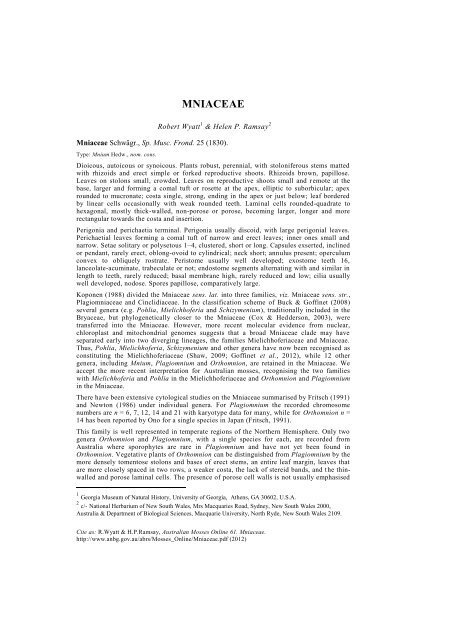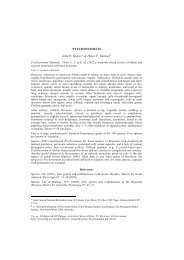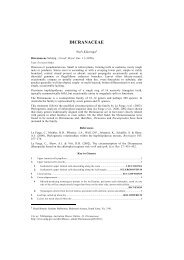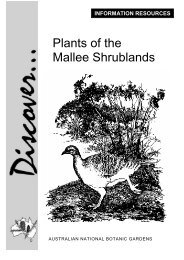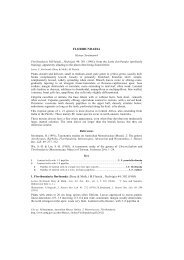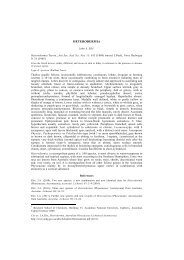Mniaceae - Australian National Botanic Gardens
Mniaceae - Australian National Botanic Gardens
Mniaceae - Australian National Botanic Gardens
Create successful ePaper yourself
Turn your PDF publications into a flip-book with our unique Google optimized e-Paper software.
MNIACEAE<br />
Robert Wyatt 1 & Helen P. Ramsay 2<br />
<strong>Mniaceae</strong> Schwägr., Sp. Musc. Frond. 25 (1830).<br />
Type: Mnium Hedw., nom. cons.<br />
Dioicous, autoicous or synoicous. Plants robust, perennial, with stoloniferous stems matted<br />
with rhizoids and erect simple or forked reproductive shoots. Rhizoids brown, papillose.<br />
Leaves on stolons small, crowded. Leaves on reproductive shoots small and remote at the<br />
base, larger and forming a comal tuft or rosette at the apex, elliptic to suborbicular; apex<br />
rounded to mucronate; costa single, strong, ending in the apex or just below; leaf bordered<br />
by linear cells occasionally with weak rounded teeth. Laminal cells rounded-quadrate to<br />
hexagonal, mostly thick-walled, non-porose or porose, becoming larger, longer and more<br />
rectangular towards the costa and insertion.<br />
Perigonia and perichaetia terminal. Perigonia usually discoid, with large perigonial leaves.<br />
Perichaetial leaves forming a comal tuft of narrow and erect leaves; inner ones small and<br />
narrow. Setae solitary or polysetous 1–4, clustered, short or long. Capsules exserted, inclined<br />
or pendant, rarely erect, oblong-ovoid to cylindrical; neck short; annulus present; operculum<br />
convex to obliquely rostrate. Peristome usually well developed; exostome teeth 16,<br />
lanceolate-acuminate, trabeculate or not; endostome segments alternating with and similar in<br />
length to teeth, rarely reduced; basal membrane high, rarely reduced and low; cilia usually<br />
well developed, nodose. Spores papillose, comparatively large.<br />
Koponen (1988) divided the <strong>Mniaceae</strong> sens. lat. into three families, viz. <strong>Mniaceae</strong> sens. str.,<br />
Plagiomniaceae and Cinclidiaceae. In the classification scheme of Buck & Goffinet (2008)<br />
several genera (e.g. Pohlia, Mielichhoferia and Schizymenium), traditionally included in the<br />
Bryaceae, but phylogenetically closer to the <strong>Mniaceae</strong> (Cox & Hedderson, 2003), were<br />
transferred into the <strong>Mniaceae</strong>. However, more recent molecular evidence from nuclear,<br />
chloroplast and mitochondrial genomes suggests that a broad <strong>Mniaceae</strong> clade may have<br />
separated early into two diverging lineages, the families Mielichhoferiaceae and <strong>Mniaceae</strong>.<br />
Thus, Pohlia, Mielichhoferia, Schizymenium and other genera have now been recognised as<br />
constituting the Mielichhoferiaceae (Shaw, 2009; Goffinet et al., 2012), while 12 other<br />
genera, including Mnium, Plagiomnium and Orthomnion, are retained in the <strong>Mniaceae</strong>. We<br />
accept the more recent interpretation for <strong>Australian</strong> mosses, recognising the two families<br />
with Mielichhoferia and Pohlia in the Mielichhoferiaceae and Orthomnion and Plagiomnium<br />
in the <strong>Mniaceae</strong>.<br />
There have been extensive cytological studies on the <strong>Mniaceae</strong> summarised by Fritsch (1991)<br />
and Newton (1986) under individual genera. For Plagiomnium the recorded chromosome<br />
numbers are n = 6, 7, 12, 14 and 21 with karyotype data for many, while for Orthomnion n =<br />
14 has been reported by Ono for a single species in Japan (Fritsch, 1991).<br />
This family is well represented in temperate regions of the Northern Hemisphere. Only two<br />
genera Orthomnion and Plagiomnium, with a single species for each, are recorded from<br />
Australia where sporophytes are rare in Plagiomnium and have not yet been found in<br />
Orthomnion. Vegetative plants of Orthomnion can be distinguished from Plagiomnium by the<br />
more densely tomentose stolons and bases of erect stems, an entire leaf margin, leaves that<br />
are more closely spaced in two rows, a weaker costa, the lack of stereid bands, and the thinwalled<br />
and porose laminal cells. The presence of porose cell walls is not usually emphasised<br />
1 Georgia Museum of Natural History, University of Georgia, Athens, GA 30602, U.S.A.<br />
2 c/- <strong>National</strong> Herbarium of New South Wales, Mrs Macquaries Road, Sydney, New South Wales 2000,<br />
Australia & Department of Biological Sciences, Macquarie University, North Ryde, New South Wales 2109.<br />
Cite as: R.Wyatt & H.P.Ramsay, <strong>Australian</strong> Mosses Online 61. <strong>Mniaceae</strong>.<br />
http://www.anbg.gov.au/abrs/Mosses_Online/<strong>Mniaceae</strong>.pdf (2012)
in descriptions of Orthomnion but is shown clearly in published illustrations [e.g. Koponen<br />
(1980a: 43, figs 16–20, 22–24); Koponen (1982a: 79, fig. 3); Eddy (1996: 197, fig. 465)].<br />
Subsection Orthomniopsis (Broth.) T.J.Kop., to which the <strong>Australian</strong> species O. elimbatum<br />
belongs, is characterised by short setae (less than 10 mm long) and trabeculate peristomes in<br />
contrast to the other subsection Oligodon T.J.Kop., not present in Australia, which has longer<br />
setae and reduced peristomes.<br />
References<br />
Beever, J.E., Alison, K.W. & Child, J. (1992), The Mosses of New Zealand. Otago University<br />
Press, Dunedin.<br />
Buck, W.R. & Goffinet, B. (2004), Morphology and classification of mosses. In A.J.Shaw &<br />
B.Goffinet (eds), Bryophyte Biology, 2nd edn, 71–123. Cambridge University Press,<br />
Cambridge.<br />
Cox, C.J. & Hedderson, T.A.J. (1999), Phylogenetic relationships among the ciliate<br />
arthrodontous mosses: evidence from chloroplast and nuclear DNA sequences, Pl. Syst. Bot.<br />
215: 119–139.<br />
Cox, C.J. & Hedderson, T.A.J. (2003), Phylogenetic relationships within the moss family<br />
Bryaceae based on chloroplast DNA evidence, J. Bryol. 25: 31–40.<br />
Dalton, P.J., Seppelt, R.D. & Buchanan, A.M. (1991), An annotated checklist of Tasmanian<br />
mosses. In M.R.Banks, S.J.Smith, A.E.Orchard & G. Kantvilas (eds), Aspects of Tasmanian<br />
Botany: A tribute to Winifred Curtis 15–32. Royal Society of Tasmania, Hobart.<br />
Eddy, A. (1996), A Handbook of Malesian Mosses 3: 194–197. Natural History Museum,<br />
London.<br />
Fritsch, R. (1991), Index to bryophyte chromosome counts, Bryophyt. Biblioth. 40: 1–352.<br />
Goffinet, B., Buck, W.R. & Shaw, A.J. (2012), Classification of Bryophytes [http:/www.<br />
eeb.uconn.edu/people/goffinet/Classificationmosses.html]<br />
Koponen, T. (1968), Generic revision of the <strong>Mniaceae</strong> Mitt. (Bryophyta), Ann. Bot. Fennici<br />
5: 117–151.<br />
Koponen, T. (1977), Miscellaneous notes on <strong>Mniaceae</strong> (Bryophyta) I. New combinations,<br />
Ann. Bot. Fennici 14: 6.<br />
Koponen, T. (1980a), A synopsis of <strong>Mniaceae</strong> (Bryophyta) II. Orthomnion, Ann. Bot. Fennici<br />
17: 35–55.<br />
Koponen, T. (1980b), A synopsis of <strong>Mniaceae</strong> (Bryophyta) III. Carl Müller’s undescribed<br />
and dubious names, Ann. Bot. Fennici 17: 61–64.<br />
Koponen, T. (1981a), A synopsis of <strong>Mniaceae</strong> ( Bryophyta) VI. Southeast Asian taxa, Acta<br />
Bot. Fennica 117: 1–34.<br />
Koponen, T. (1981b), A synopsis of <strong>Mniaceae</strong> (Bryophyta) VII. List of species and their<br />
distribution, Ann. Bot. Fennici 18: 113–115.<br />
Koponen, T. (1982a), The family <strong>Mniaceae</strong> in Australasia and the Pacific, J. Hattori Bot.<br />
Lab. 52: 75–86.<br />
Koponen, T. (1982b), Generic and family concepts in the <strong>Mniaceae</strong>, Beih. Nova Hedwigia<br />
71: 249–259.<br />
Koponen, T. (1982c), Miscellaneous notes on <strong>Mniaceae</strong> (Bryophyta) XI. Distribution of<br />
Plagiomnium rostratum, Mem. Soc. Fauna Fl. Fennica 58: 17–20.<br />
Koponen T. (1983), A synopsis of <strong>Mniaceae</strong> (Bryophyta) VIII. Taxa in Australia and New<br />
Zealand, Ann. Bot. Fennici 20: 101–104.<br />
Koponen T. (1988), The phylogeny and classification of <strong>Mniaceae</strong> and Rhizogoniaceae<br />
(Musci), J. Hattori Bot. Lab. 64: 37–46.<br />
2
Koponen T. & Norris, D.H. (1983), Bryophyte flora of the Huon Peninsula, Papua New<br />
Guinea II. <strong>Mniaceae</strong>, Ann. Bot Fennici 20: 31–40.<br />
Newton, M.E. (1986), Bryophyte phylogeny in terms of chromosome cytology, J. Bryol. 14:<br />
215–230.<br />
Noguchi, A. (1974), Notes on the genus Orthomnion (Musci), Misc. Bryol. Lichenol. 6:<br />
57–159.<br />
Ramsay, H.P. (2011), <strong>Australian</strong> mosses – new chromosome numbers and a compilation of<br />
chromosome data, Telopea 13: 577–619.<br />
Ramsay, H.P. & Cairns, A. (2004), Habitat, distribution and the phytogeographical affinities<br />
of mosses in the Wet Tropics bioregion, northeast Queensland, Australia, Cunninghamia 8:<br />
371–408.<br />
Sainsbury, G.O.K. (1955), A handbook of New Zealand mosses, Bull. Roy. Soc. New Zealand<br />
5: 1–490.<br />
Shaw, A.J. (2009), Bryophyte Flora of North America: Mielichhoferiaceae. Provisional<br />
publication Missouri <strong>Botanic</strong>al Garden. [http://mobot.org/plantscience/BFNA/bfnamenu.htm,<br />
accessed May 2012]<br />
Key to Species<br />
Leaves of erect stems orbicular; apices rounded-obtuse; border weak, undulate; margin entire; laminal cell<br />
walls porose; dioicous; setae short; capsules erect; epiphytic ............................ Orthomnion elimbatum<br />
Leaves of erect stems elliptic to ovate; apices rounded, with a short apiculus; border of 3 or 4 rows of narrow<br />
elongate cells; margin toothed; laminal cell walls non-porose; synoicous; setae elongate; capsules<br />
horizontal to nutant; calcicolous ............................................................. Plagiomnium novaezelandiae<br />
3


